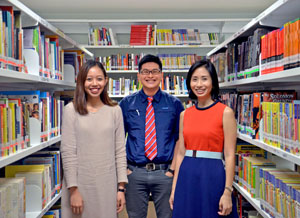Why Singapore’s English Teachers Should Embrace Singlish, Not Fight It
Is it time for Singaporean educators to embrace Singlish as a legitimate learning tool? What the Research […]
Read More
Creating a school-wide reading culture is no mean feat. Not only is the support and involvement of all teachers crucial, it can also take months or years of experimenting to refine programmes and realize a shared learning vision. We speak to three teachers from Edgefield Secondary School about their school-wide reading programme and how it benefits their students.
Famous author Neil Gaiman once said at a lecture he gave in London: “The simplest way to make sure that we raise literate children is to teach them to read, and to show them that reading is a pleasurable activity” (Gaiman, 2013).
This is what teachers from Edgefield Secondary School are working towards through their Intensive and Extensive Reading Programme. Initiated by Vice-Principal Mr Tan Chai Hok in 2013 with teachers selecting newspaper articles for students to acquaint them with current affairs, the programme has since evolved into a comprehensive, school-wide effort to foster a love of reading in all students.

Ns Nur Shahidah, Mr Brennan Kwa and Ms Tan Yih Tyan (from left to right) are part of the reading committee at Edgefield Secondary School.
In 2014, a reading committee was formed to coordinate different aspects of the school’s reading programme.
Teachers play different roles in the committee, says Head of Department (English) Ms Tan Yih Tyan. To ensure a proper structure within the committee, she and Literature teacher Mr Brennan Kwa work closely to plan a customized reading schedule and activities for each level.
Each English Language teacher is assigned a different topic or genre and contributes four articles to a reading repository.
“Everyone contributes. That is how we came up with a whole repository of articles for each level,” explains Yih Tyan. “At the end of the year, the committee gets feedback from the teachers and reviews the articles to ensure they are interesting and relevant.”
Students read and learn from these articles during their dedicated weekly or fortnightly reading periods.
“But the way to kill their love for reading is to make it seem like it is an extension of an English lesson,” says Brennan. And so, teachers include a mix of both fiction and non-fiction topics outside of the school curriculum. The topics include sports, science, sci-fi, fantasy and even horror.
The Vice-Principal also supports the programme by contributing articles and his own writing. Some teachers also include comics in the reading articles or get students to view short clips during the reading lesson.
“We do this because we want to inculcate a love for reading in students,” Brennan explains. “These are things that students don’t always encounter if left to read on their own.”
Reading together with the students, the teachers then try to engage them by bringing them through a series of reflective discussion questions that are tailored to evoke various emotions and critical responses from students as well as encourage them to think critically.
“The way to kill (students’) love for reading is to make it seem like (the reading programme) is an extension of an English lesson.”
– Brennan Kwa, on why school reading programmes should be carefully planned
There are various ways to conduct a reading session in the classroom. Some teachers read the first paragraph out-loud to set the mood and context for students to continue on their own, while others assign pre-reading tasks or write pertinent questions on the board before asking their students to read.
Following the reading session, about 3–4 questions pertaining to the topic of the texts are tabled. “We ask them questions such as: What would you do if you were in the shoes of this person? Would you do something different? Do you agree with the opinions of the writer? What would you like to add?” shares Yih Tyan.
The aim is not just to improve literacy, but to also promote deeper engagement with texts.
“We want students to have an idea of what is going on around the world,” Yih Tyan adds. “By asking purposeful questions, teachers can encourage reflection on issues and even develop empathy in students for the people and characters they read about.”
Brennan chimes in, “When you are reading, you can be a prince, a dragon, a 10-year-old, anything you want to be. It makes them see things differently.”

The reading committee believes that reading helps students to understand situations from different viewpoints.
This intensive reading in the classroom is further complemented by the school’s Extensive Reading Programme. Regular school library visits are scheduled for students to pick what they want to read and build a habit of reading for pleasure.
“We hope that by allowing them to choose what they want to read, they will find reading more enjoyable.” To further increase their interest, the reading committee also conducts monthly library quizzes that students can take part in and win small tokens of appreciation such as bookstore vouchers.
“We ask them simple questions which require them to pop by the library to find the answers, like ‘Give the title of one book that is featured in the library this month’ and ‘Which section in the library can you find this particular book?’” Yih Tyan adds. “We hope that while they are there, they see a title they like and borrow a book.”
These library visits are not just limited to the school library. Students are also encouraged to visit the public libraries on their own and loan books that they find interesting.
Brennan believes such enrichment programmes are important to inspire a love of reading in students. Instead of forcing reluctant readers to read, the teachers hope that the exposure to these reading programmes will “capture their attention or interest on a particular day so that they find themselves wanting to read”.
“When children read widely, it will naturally translate to better English results,” says Yih Tyan.
Today, their students write better and class discussions have improved. The reading programme even ties in well with other parts of the curriculum such as Social Studies where knowledge of current affairs is required.
However, Brennan cautions that teachers who are thinking of starting their own reading programmes should not do so for the sake of grades. He emphasizes, “If you start out with I am doing this for the grades then you are missing the point. We do this because we want to inculcate a love of reading!”
Reference
Gaiman, N. (2013, October). Neil Gaiman: Reading and obligation [Video file]. Retrieved from https://readingagency.org.uk/news/blog/neil-gaiman-lecture-in-full.html